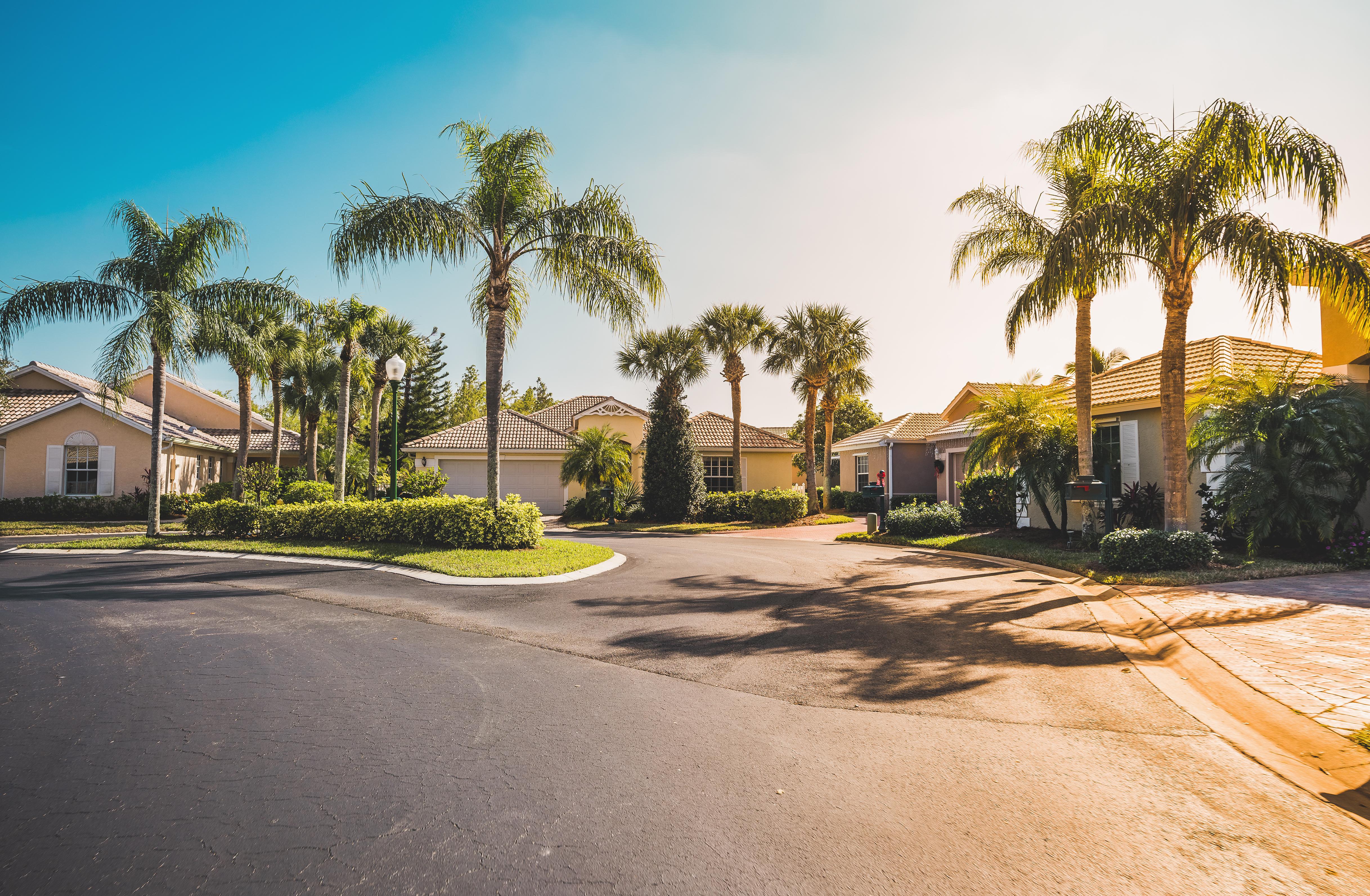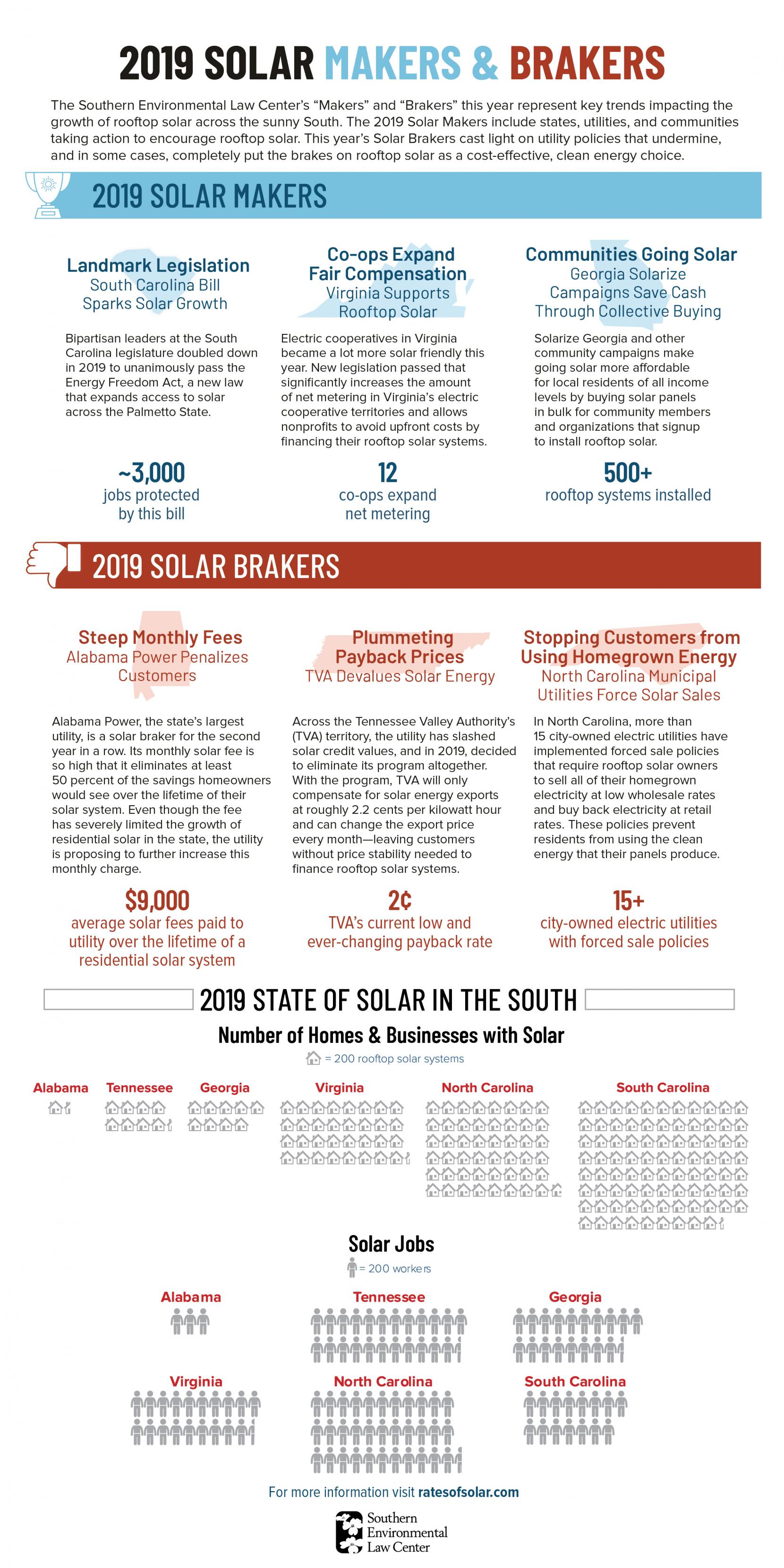As with any new technology, legislation can advance or slow down its progress. As solar power gains widespread acceptance, conflicting policies abound as some camps try to slow down the unstoppable trend toward renewable energy. Here's a look at interesting developments in select southern states.
Today the Southern Environmental Law Center announced its 2019 Solar "Makers" and "Brakers" list highlighting key trends in policies and actions impacting the growth of rooftop solar across the sunny South.
The announcement coincides with the organization's annual update of its Rates of Solar website, reflecting the most current utility solar policies in the South. The digital resource provides simple information about how utilities are treating rooftop solar customers.
Solar is booming across the South as more homeowners turn to clean, affordable rooftop solar to meet their energy needs and state policy makers embrace local solar growth and the benefits that come with it. According to a recent report by the Solar Energy Industries Association, solar capacity is expected to more than double over the next 5 years. Currently the Southeast has over nine gigawatts of solar installed, and over 14 gigawatts installed or committed.
"We are seeing solar energy make great strides forward in the sunny South," said Lauren Bowen, Lead Attorney for SELC's Solar Power Initiative. "However, there is so much more solar potential in our region. Regulatory and utility policies have an enormous impact on whether we'll be able to reach that potential or not."
Last year SELC launched Rates of Solar to share and summarize complicated and often difficult-to-find rooftop solar policies for over 400 utilities across the South.
Southerners have some of the highest residential electric bills in the country and going solar is one of the few options that customers have to reduce the amount of energy they buy from utilities and lower their bills. Yet, residents across the region interested in putting solar on their homes, schools or businesses must first consider their utility's rooftop solar policies before making the investment to determine if it's a feasible option.
"The updated Rates of Solar website ensures we have the most current solar policies for hundreds of utilities across SELC's six-state region," said Jill Kysor, SELC staff attorney. "Our website provides simple, straightforward information for homeowners about how utilities across the Southeast are treating customers who install rooftop solar. During the process of collecting and updating these sometimes hard-to-get policies, we identified several regional trends impacting the growth of rooftop solar."
The 2019 Solar Makers list highlights three examples of state, utility, and community actions driving rooftop solar progress in the region. This year's Solar Brakers list casts light on the utility policy trends that undermine, and in some cases, completely put the brakes on rooftop solar as a cost-effective, clean energy choice.
The 2019 Solar Makers:
- Landmark Legislation: South Carolina Bill Sparks Solar Growth
- Bipartisan leaders at the South Carolina legislature doubled down in 2019 to unanimously pass the Energy Freedom Act, a new law that expands access to solar across the Palmetto State. South Carolina has emerged as one of the nation's fastest-growing rooftop solar markets primarily due to legislation that was put in place in 2014. However, when the number of rooftop installations started hitting program caps in Duke Energy and Dominion Energy South Carolina territories set in that 2014 bill and large-scale solar interconnections slowed, state leaders jumped back into action to extend and expand the programs, building on the state's previous solar success and the nearly 3,000 jobs it had created.
- Co-ops Expand Fair Compensation: Virginia Supports Rooftop Solar
- Electric cooperatives in Virginia became a lot more solar friendly this year. New legislation passed that significantly increased the amount of net metering available to customers served by Virginia's electric cooperatives. In addition, electric cooperatives in the state will now allow non-profits to finance rooftop solar systems through Power Purchase Agreements (PPAs). This option avoids large upfront costs for installing solar systems making it much easier for schools and churches to get solar on their rooftops.
- Communities Going Solar: Georgia Solarize Campaigns Save Cash Through Collective Buying
- More and more communities are coming together to collectively invest in solar to bring down the price. These programs, like Solarize Georgia, make solar more affordable for Southerners of all income levels by buying solar panels in bulk for community members and organizations signing up to install rooftop solar on their properties. Solarize Georgia campaigns have brought more than 500 rooftop systems online in cities like Atlanta, Athens, Oxford and others across the state for a combined total 3.5 megawatts of collective solar installed in Georgia. By avoiding the use of electricity from fossil fuels, Solarize Georgia is also reducing greenhouse gas emissions from traditional power plants that dominate the grid. The program estimates that more than 87,000 tons of carbon dioxide will be avoided with its current installations over the next 25 years.
The 2019 Solar Brakers:
- Steep Monthly Fees: Alabama Power Penalizes Customers
- Across the South, many electric utilities impose extra monthly charges on customers who install rooftop solar. In some cases, these fees are significant and dramatically reduce or eliminate the savings a solar customer would receive from their rooftop system. Alabama Power, which serves the majority of the state's residents, imposes a solar fee that is so high it ultimately eliminates at least 50 percent of the savings homeowners would see over the lifetime of their rooftop solar system. Even though the steep monthly charge has severely limited the growth of rooftop solar in the state, Alabama Power is proposing to further increase this monthly solar charge.
- Plummeting Payback Prices: TVA Devalues Solar Energy
- Many utilities in the region credit solar customers for excess energy pushed back onto the grid at a price well below the utility's retail rate. Low payback prices make the economics of installing rooftop solar very difficult. While most customers are buying electricity at a price of more than 10 cents per kilowatt hour on average, they might only be credited a few cents per kilowatt hour from the homegrown excess solar energy provided back to the grid during sunny afternoons. This is true in the Tennessee Valley Authority's territory, where the utility slashed solar credit values over the past several years and in 2019 decided to terminate its program altogether. Outside of the soon-to-be defunct program, TVA currently compensates for solar energy exports at roughly 2.2 cents per kilowatt hour and changes the export price every month - leaving customers without price stability needed to finance rooftop solar systems.
- Stopping Customers from Using Homegrown Energy: North Carolina Municipal Utilities Force Solar Sales
- A huge benefit of customers going solar is that they can use their own homegrown clean, renewable energy to meet their needs before buying energy from their utility. Unfortunately, a growing number of utilities in the region are implementing policies that don't allow customers to use their solar energy to power their homes. Instead, customers are forced to buy all their energy at retail rates from the utility and sell all of their self-generated solar energy to the utility at lower wholesale rates. In North Carolina, more than 15 city-owned electric utilities have implemented these forced sale policies, severely limiting the ability of their resident-customers to go solar.
For more than 30 years, the Southern Environmental Law Center has used the power of the law to champion the environment of the Southeast. With more than 80 attorneys and nine offices across the region, SELC is widely recognized as the Southeast's foremost environmental organization and regional leader. SELC works on a full range of environmental issues to protect our natural resources and the health and well-being of all the people in our region.
This article was from James Madison University / The Breeze and was legally licensed through the NewsCred publisher network. Please direct all licensing questions to legal@newscred.com.





